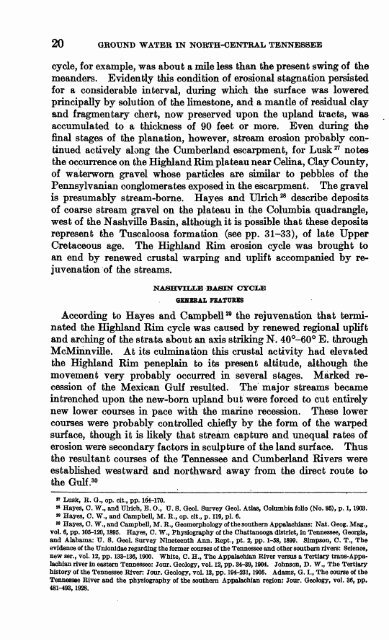GROUND WATER IN NORTH-CENTRAL TENNESSEE
GROUND WATER IN NORTH-CENTRAL TENNESSEE
GROUND WATER IN NORTH-CENTRAL TENNESSEE
Create successful ePaper yourself
Turn your PDF publications into a flip-book with our unique Google optimized e-Paper software.
20 <strong>GROUND</strong> <strong>WATER</strong> <strong>IN</strong> <strong>NORTH</strong>-<strong>CENTRAL</strong> <strong>TENNESSEE</strong><br />
cycle, for example, was aboufc a mile less than the present swing of the<br />
meanders. Evidently this condition of erosional stagnation persisted<br />
for a considerable interval, during which the surface was lowered<br />
principally by solution of the limestone, and a mantle of residual clay<br />
and fragmentary chert, now preserved upon the upland tracts, was<br />
accumulated to a thickness of 90 feet or more. Even during the<br />
final stages of the planation, however, stream erosion probably con<br />
tinued actively along the Cumberland escarpment, for Lusk 27 notes<br />
the occurrence on the Highland Eim plateau near Celina, Clay County,<br />
of waterworn gravel whose particles are similar to pebbles of the<br />
Pennsylvanian conglomerates exposed in the escarpment. The gravel<br />
is presumably stream-borne. Hayes and Ulrich 28 describe deposits<br />
of coarse stream gravel on the plateau in the Columbia quadrangle,<br />
west of the Nashville Basin, although it is possible that these deposits<br />
represent the Tuscaloosa formation (see pp. 31-33), of late Upper<br />
Cretaceous age. The Highland Eim erosion cycle was brought to<br />
an end by renewed crustal warping and uplift accompanied by re<br />
juvenation of the streams.<br />
NASHVILLE BAS<strong>IN</strong> CYCLE<br />
GENERAL FEATURES<br />
According to Hayes and Campbell 29 the rejuvenation that termi<br />
nated the Highland Eim cycle was caused by renewed regional uplift<br />
and arching of the strata about an axis striking N. 40°-60° E. through<br />
McMinnville. At its culmination this crustal activity had elevated<br />
the Highland Eim peneplain to its present altitude, although the<br />
movement very probably occurred in several stages. Marked re<br />
cession of the Mexican Gulf resulted. The major streams became<br />
intrenched upon the new-born upland but were forced to cut entirely<br />
new lower courses in pace with the marine recession. These lower<br />
courses were probably controlled chiefly by the form of the warped<br />
surface, though it is likely that stream capture and unequal rates of<br />
erosion were secondary factors in sculpture of the land surface. Thus<br />
the resultant courses of the Tennessee and Cumberland Eivers were<br />
established westward and northward away from the direct route to<br />
the Gulf.30<br />
» Lusk, E. O., op. cit., pp. 164-170.<br />
» Hayes, C. W., and Ulrich, E. O., U. S. Oeol. Survey Geol. Atlas, Columbia folio (No. 95), p. 1,1903.<br />
» Hayes, C. W., and Campbell, M. K., op. cit., p. 119, pi. 6.<br />
w Hayes, C. W., and Campbell, M. E., Qeomorphology of the southern Appalachians: Nat. Qeog. Mag.,<br />
vol. 6, pp. 105-120,1895. Hayes, C. W., Physiography of the Chattanooga district, in Tennessee, Georgia,<br />
and Alabama: U. S. Oeol. Survey Nineteenth Ann. Kept., pt. 2, pp. 1-58, 1899. Simpson, C. T., The<br />
evidence of the Unionidae regarding the former courses of the Tennessee and other southern rivers: Science,<br />
new ser., vol. 12, pp. 133-136,1900. White, C. H., The Appalachian Eiver versus a Tertiary trans-Appa-<br />
lachian river in eastern Tennessee: Jour. Geology, vol. 12, pp. 34-39,1904. Johnson, D. W., The Tertiary<br />
history of the Tennessee River: Jour. Geology, vol. 13, pp. 194-231,1905. Adams, G. I., The course of the<br />
Tennessee Biver and the physiography of the southern Appalachian region: Jour. Geology, vol. 36, pp.<br />
481-493, 1928.

















